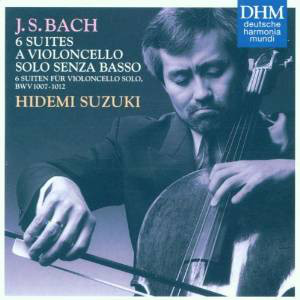
Hidemi Suzuki. Bach Cello Suites. Deutsche Harmonia Mundi CD 05472773872
Released 1996 Recorded 4-8th September 1996 Luthersekerk, Haarlem NL.
Cellos used: Andrea Amati ca. 1570. For sixth Suite, 5 string Violoncello piccolo Anonym.
Introduction.
This is the first of two recordings by the Japanese Baroque expert. He lives in the Netherlands where one of his mentors has been Anner Bylsma.
The Cello.
Firstly, the cello used for the first five Suites fascinates me. I took a double look at the date ascribed to the instrument’s creation. However this does appear to be the date of the earliest string instruments made in the form we are now familiar with. The finding that really amazes me is that the sound is so rich and resonant. It is the main feature of the recording such that the change of instrument for the sixth Suite is a little of an anti-climax. The sound of the cello piccolo is slightly pinched and nasal by comparison. I would draw favourable comparison with Anner Bylsma’s second recording. On that, he plays the Suites using the Servais Stradivarius cello.
Here are a couple of links of interest to another cello by Andrea Amati:
https://tarisio.com/cozio-archive/property/?ID=40046
This You Tube video suggests that Suzuki himself has reservations regards the cello’s provenance. Not sure that should be a major issue given its sound!
https://www.youtube.com/watch?v=4tW62vmLGLc
The Recording.
I judge this to be a fine recording with natural acoustic. It captures the cello and its player at their best. There is little extraneous noise. However, in faster passages I am aware of what one might call scrubbing of the bow on the string. Nevertheless, for the most part I found I could concentrate on the music as opposed to being distracted by breathing or finger board tapping. A wide variety of dynamics are well captured.
The Music.
Whilst the set up and background to the recording underline the Baroque credentials, the interpretation is in that middle ground of many mainstream recordings. Articulation is clear but not emphasised. Sustained notes are held for full value and in fact I noted that a repeated feature of endings with double stopping is to finish on the upper string alone after a second or two.
There is some ornamentation but not any more than many modern interpretations. Speeds are generally faster than the norm except the Sarabandes which tend to be slower. The third Suite is exceptionally fast and I fear suffers for it sounding rather messy at times. This I think was down to the resonant lower strings. Technically Suzuki is exceptional. I note from the booklet provided, that Suzuki makes the observation that in the Kellner edition of the manuscript the third Prelude is marked Presto! I’m not sure about this kind of slavish observation to speed markings. Most music I feel has a natural speed suggested by the way it is written. In that way the Allemandes of the sixth and fifth Suites demand a slower tempo whilst the second and third to my mind sound best played quite briskly. The first and fourth lie somewhere in between.
Generally, I found Suzuki phrases the music in broad brush strokes, rather than intense detail. Together with the cello sound this provides a relaxing and quite seductive listen, until one gets to a rather rushed passage! Fortunately outside the third Suite there are not too many of those!
Another quirky touch I found was that the second Suite Minuet 1 was played with a dotted rhythm rather than even quavers. Rather pleasant and sets the music off with a swing.
Conclusion.
A lovely cello sound with seductive qualities which some very lively playing by Suzuki enhances. The notes appear to be authored by the performer and are notable due to their lack of pretentiousness! Not one to ignore.